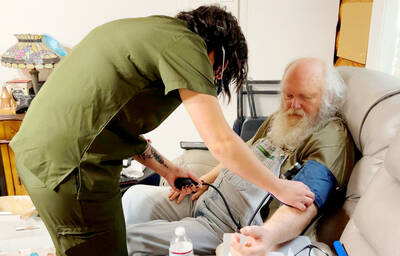The first retrospective of work by Tracey Emin, the enfant terrible artist who has made a career out of intimate personal details including her own unmade bed, has opened to mixed reviews.
As well as My Bed, a mess of vodka bottles, cigarette butts and dirty underwear, Tracey Emin: 20 Years also features Conversations With My Mum, a video of her talking to her mother, and It’s Not the Way I Want to Die, a model of the roller coaster in her hometown of Margate.
The show, at the Scottish National Gallery of Modern Art, has attracted more than 13,000 visitors in the three weeks since it opened, but many critics have been scathing, accusing her of being unsubtle and self-important.
Most of the works focus on the artist’s own life — her teenage years, being raped at the age of 13, relationships and fears about never being a mother — with an unblinking intensity.
“Emin has turned her life into a public spectacle like no other artist before her,” wrote Patrick Elliott, the exhibition’s curator, in its catalogue.
Born in 1963, Emin is, alongside figures such as Damien Hirst, associated with the Young British Artists group that emerged in London in the 1990s.
Her eye-opening works have made her a household name and brought financial success — millionaire advertising guru Charles Saatchi, a major collector of contemporary British art, has repeatedly snapped up her pieces.
Emin has gradually become part of the art establishment — she became a member of the Royal Academy in 2007 and represented Britain at the Venice Biennale last year.
But she still draws stinging reviews from some critics.
“By the end of this show, I felt as if someone had been shouting at me down the phone for a couple of hours — a kind of emotional earache,” the Guardian newspaper’s reviewer wrote.
The Times was hardly more flattering — “What distresses me far more than Emin’s taste for the obscene ... is her amazing, unshakable faith in her own importance,” its reviewer said. Visitors to the Edinburgh show were divided in their reactions, meanwhile.
“Heavy, boring, rubbish” and “personal, thought-provoking, absorbing” were just two of the comments left in a visitors book.
The show runs in Edinburgh until Nov. 9 and travels to the Contemporary Art Center in Malaga, Spain from Nov. 28 to Feb. 22, 2009, and the Art Museum in Bern, Switzerland from March 10, 2009 to June 21, 2009.

Oct. 27 to Nov. 2 Over a breakfast of soymilk and fried dough costing less than NT$400, seven officials and engineers agreed on a NT$400 million plan — unaware that it would mark the beginning of Taiwan’s semiconductor empire. It was a cold February morning in 1974. Gathered at the unassuming shop were Economics minister Sun Yun-hsuan (孫運璿), director-general of Transportation and Communications Kao Yu-shu (高玉樹), Industrial Technology Research Institute (ITRI) president Wang Chao-chen (王兆振), Telecommunications Laboratories director Kang Pao-huang (康寶煌), Executive Yuan secretary-general Fei Hua (費驊), director-general of Telecommunications Fang Hsien-chi (方賢齊) and Radio Corporation of America (RCA) Laboratories director Pan

President William Lai (賴清德) has championed Taiwan as an “AI Island” — an artificial intelligence (AI) hub powering the global tech economy. But without major shifts in talent, funding and strategic direction, this vision risks becoming a static fortress: indispensable, yet immobile and vulnerable. It’s time to reframe Taiwan’s ambition. Time to move from a resource-rich AI island to an AI Armada. Why change metaphors? Because choosing the right metaphor shapes both understanding and strategy. The “AI Island” frames our national ambition as a static fortress that, while valuable, is still vulnerable and reactive. Shifting our metaphor to an “AI Armada”

The older you get, and the more obsessed with your health, the more it feels as if life comes down to numbers: how many more years you can expect; your lean body mass; your percentage of visceral fat; how dense your bones are; how many kilos you can squat; how long you can deadhang; how often you still do it; your levels of LDL and HDL cholesterol; your resting heart rate; your overnight blood oxygen level; how quickly you can run; how many steps you do in a day; how many hours you sleep; how fast you are shrinking; how

“‘Medicine and civilization’ were two of the main themes that the Japanese colonial government repeatedly used to persuade Taiwanese to accept colonization,” wrote academic Liu Shi-yung (劉士永) in a chapter on public health under the Japanese. The new government led by Goto Shimpei viewed Taiwan and the Taiwanese as unsanitary, sources of infection and disease, in need of a civilized hand. Taiwan’s location in the tropics was emphasized, making it an exotic site distant from Japan, requiring the introduction of modern ideas of governance and disease control. The Japanese made great progress in battling disease. Malaria was reduced. Dengue was